
|
Great outburst occured on Oct. 24, 2007, and it bacame a naked eye comet of 2 mag. It kept so bright as 5.5 mag still on Apr. 30 (Carlos Labordena), but it was extremely faint and difficult to see. The size was so large, the diameter was larger than 60 arcmin. It is not observable in this summer. But it will become observable in good condition in autumn again. The extremely faint large diffuse object may be detected with a best sky condition, around 5-6 mag with a diameter of 1 or 2 degrees.
Date(TT) R.A. (2000) Decl. Delta r Elong. m1 Best Time(A, h)
July 26 7 37.74 31 25.1 4.559 3.591 15 6.1 3:25 (228, -2)
Aug. 2 7 47.35 30 56.5 4.561 3.619 19 6.1 3:33 (232, 1)
|
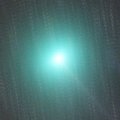
|
It became so bright as 4.7 mag, and so large as 20 arcmin in June (June 12, Marco Goiato). Now it is fading. But it is still bright as 7.3 mag (July 29, Marco Goiato). It keeps observable in good condition for a long time after this. It will be visible visually until around November.
Date(TT) R.A. (2000) Decl. Delta r Elong. m1 Best Time(A, h)
July 26 2 54.79 14 48.8 0.469 1.024 77 7.0 3:25 (282, 42)
Aug. 2 2 48.33 17 27.2 0.513 1.097 85 7.5 3:33 (287, 52)
|
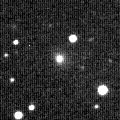
|
Now it is 9.4 mag (July 26, Alexandre Amorim). The brightness evolution got slow down in July. It is expected to be 7.5 mag in September. It keeps moving in the southern sky, and it is unobservable for a while in the Northern Hemisphere. It will appear in the evening sky at 8 mag in late September, but it keeps locating in the evening low sky until the end of 2008 when it fades out down to 10 mag. Then it turns to appear in the morning sky, and it keeps observable in the northern sky after that while fading gradually. In the Southern Hemisphere, it keeps observable until late October.
Date(TT) R.A. (2000) Decl. Delta r Elong. m1 Best Time(A, h)
July 26 8 19.31 -43 8.6 1.665 1.499 62 8.9 3:25 (298,-50)
Aug. 2 8 53.59 -45 0.1 1.569 1.426 62 8.6 20:38 ( 59,-49)
|
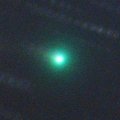
|
Now it is so bright as 9.2 mag (July 15, Juan Jose Gonzalez). Although it kept locating extremely low for a while in the Northern Hemisphere, it is getting higher gradually after this. It will be fading gradually after this, but it will be visible visually until September.
Date(TT) R.A. (2000) Decl. Delta r Elong. m1 Best Time(A, h)
July 26 5 22.60 25 25.1 1.608 1.086 41 10.3 3:25 (251, 18)
Aug. 2 5 48.86 26 12.0 1.651 1.134 42 10.6 3:33 (251, 20)
|
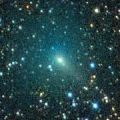
|
Now it is so bright as 10.2 mag (July 29, Jose Carvajal). In the Northern Hemisphere, it keeps observable until 2009 spring when the comet becomes faint. It will move near by the Northern Pole from summer to autumn, and will be observable all night. It keeps bright at 10 mag until August, then it will be visible visually until around October. In the Southern Hemisphere, it will never be observable again.
Date(TT) R.A. (2000) Decl. Delta r Elong. m1 Best Time(A, h)
July 26 21 58.91 78 56.9 1.577 1.732 80 10.3 1:44 (180, 46)
Aug. 2 21 45.86 82 26.9 1.613 1.743 79 10.5 1:03 (180, 43)
|
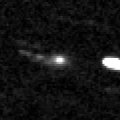
|
Now it is so bright as 9.5 mag (July 13, Marco Goiato). It is also bright as 10.7 mag by CCD (July 27, Ken-ichi Kadota), brighter than originally predicted. The condition in this apparition is bad. In the Southern Hemisphere, it keeps extremely low, or under the horizon, so it will not be observable. In the Northern Hemisphere, it is finally appearing in the morning sky. It keeps observable and fading in the morning sky after this.
Date(TT) R.A. (2000) Decl. Delta r Elong. m1 Best Time(A, h)
July 26 6 16.63 22 12.0 2.145 1.355 29 10.4 3:25 (247, 6)
Aug. 2 6 40.92 23 42.1 2.132 1.360 30 10.4 3:33 (247, 9)
|
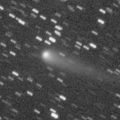
|
Now it is bright as 11.7 mag (July 15, Juan Jose Gonzalez), brightening almost as expected. It will reach to 10.5 mag and will be observable in good condition in 2008 autumn. It keeps observable, visible visually, brighter than 14 mag for one year until 2009 May.
Date(TT) R.A. (2000) Decl. Delta r Elong. m1 Best Time(A, h)
July 26 3 11.74 45 52.4 2.699 2.497 67 11.1 3:25 (238, 49)
Aug. 2 3 28.50 47 38.4 2.628 2.481 70 11.0 3:33 (235, 52)
|
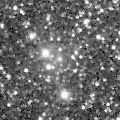
|
Now it is 12.7 mag (July 27, Jose Carvajal). Brightening rapidly as expected, and a coma of about 1-2 arcmin is visible. It will reach up to 9 mag and keep bright for a long time from summer to autumn. In the Northern Hemisphere, it becomes low in the south at brightest, but it keeps observable until it fades out.
Date(TT) R.A. (2000) Decl. Delta r Elong. m1 Best Time(A, h)
July 26 19 48.92 0 51.7 0.377 1.373 158 11.6 23:31 ( 0, 55)
Aug. 2 19 56.45 -5 2.6 0.360 1.362 161 11.1 23:11 ( 0, 49)
|
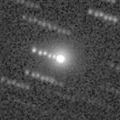
|
Now it is 11.1 mag (July 29, Marco Goiato). Small and strongly condensed. It is expected to reach to 6 mag in 2009 February. It keeps observable until October.
Date(TT) R.A. (2000) Decl. Delta r Elong. m1 Best Time(A, h)
July 26 19 38.84 -19 44.5 1.665 2.671 169 11.9 23:18 ( 0, 35)
Aug. 2 19 10.56 -20 40.1 1.631 2.594 156 11.7 22:22 ( 0, 34)
|
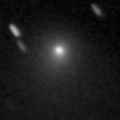
|
It reached to 10.9 mag in May (May 11, Marco Goiato). Now it is fading slowly. It has already faded down to 12.0 mag (July 21, Alexandre Amorim). In the Southern Hemisphere, it keeps observable until late August when it fades down to 12 mag. In the Northern Hemisphere, it will be unobservable soon. But it will appear in the morning sky again at 13 mag at the end of 2008, then it keeps bright and observable for a while.
Date(TT) R.A. (2000) Decl. Delta r Elong. m1 Best Time(A, h)
July 26 11 40.35 -5 0.2 3.237 2.773 54 11.8 20:46 ( 81, 5)
Aug. 2 11 51.30 -4 23.1 3.322 2.780 49 11.8 20:38 ( 82, 3)
|
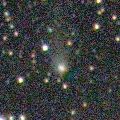
|
Now it is bright as 11.7 mag (July 8, Marco Goiato). It keeps bright at 12 mag for a long time from 2008 spring to 2009 spring. However, it is only observable until mid August in the Northern Hemisphere because the comet moves southwards. It keeps observable for a long time in the Southern Hemisphere.
Date(TT) R.A. (2000) Decl. Delta r Elong. m1 Best Time(A, h)
July 26 15 43.65 -32 7.1 2.296 2.902 117 11.9 20:46 ( 18, 20)
Aug. 2 15 34.97 -33 30.1 2.379 2.873 108 12.0 20:38 ( 24, 17)
|
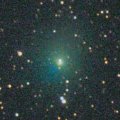
|
It reached up to 9.5 mag on Mar. 29 (Maik Meyer). Now it is fading slowly. It faded down to 10.7 mag on May 11 (Marco Goiato), and it was a diffuse object with a weak condensation. In the Northern Hemisphere, it will never be observable again. In the Southern Hemisphere, it keeps observable until it fades out. No observations have been reported recently, and the current brightness is uncertain.
Date(TT) R.A. (2000) Decl. Delta r Elong. m1 Best Time(A, h)
July 26 9 19.45 -29 51.3 2.402 1.934 51 13.1 20:46 ( 76,-37)
Aug. 2 9 34.86 -32 41.9 2.473 2.007 51 13.3 20:38 ( 73,-39)
|
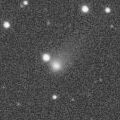
|
Now it is bright as 12.7 mag (Apr. 12, Marco Goiato). In the Northern Hemisphere, it got very low in the evening sky, and will be unobservable soon. Then the comet will go southwards, so it will never be observable again in the Northern Hemisphere. In the Southern Hemisphere, it keeps observable in good condition for a long time until autumn.
Date(TT) R.A. (2000) Decl. Delta r Elong. m1 Best Time(A, h)
July 26 12 34.99 -12 36.5 3.177 2.986 69 14.0 20:46 ( 66, 11)
Aug. 2 12 42.56 -14 0.5 3.253 2.981 65 14.0 20:38 ( 67, 7)
|

|
It was 15 mag on Jan. 14 (Michael Mattiazzo), brightening as expected. It will reach to 13.5 mag in the southern sky in spring and summer. In the Southern Hemisphere, it keeps observable for a long time after this. But in the Northern Hemisphere, it is not observable now. But it will appear in the morning sky at 15 mag in November, then it keeps observable while the comet will be fading slowly.
Date(TT) R.A. (2000) Decl. Delta r Elong. m1 Best Time(A, h)
July 26 8 41.17 -34 38.3 3.015 2.558 54 14.0 20:46 ( 74,-46)
Aug. 2 8 59.28 -33 53.7 3.078 2.575 51 14.0 20:38 ( 75,-46)
|

|
Now it is not observable. In the last season, it became so bright as 10 mag in 2008 January. It will appear in the morning sky in late August.
Date(TT) R.A. (2000) Decl. Delta r Elong. m1 Best Time(A, h)
July 26 7 22.76 25 44.8 7.020 6.046 15 14.1 3:25 (235, -4)
Aug. 2 7 28.51 25 30.9 6.989 6.048 20 14.1 3:33 (239, 1)
|
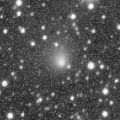
|
It is already bright as 13.2 mag and visible visually (July 8, Juan Jose Gonzalez). It is expected to reach to 11 mag in 2009 summer. Because it moves in the northern sky, it keeps observable until it becomes brightest in the Northern Hemisphere.
Date(TT) R.A. (2000) Decl. Delta r Elong. m1 Best Time(A, h)
July 26 4 8.75 64 3.1 4.905 4.502 61 14.2 3:25 (212, 41)
Aug. 2 4 8.95 65 17.5 4.779 4.457 65 14.1 3:33 (210, 44)
|

|
It was 16.1 mag on Mar. 30 (S. G. McAndrew), brightening well as expected at that time. It is not observable in the Northern Hemisphere now, but observable in good condition in the Southern Hemisphere. However, no observations have been reported since mid April. It must be already brightening up to 15 mag, but the actual brightness is uncertain. It is expected to brighten up to 10 mag from late 2009 to early 2010. Because the comet moves in the southern sky for a long time, it keeps impossible or very hard to observe in the Northern Hemisphere until 2009 September. But after 2009 October, it is observable at 10 mag for a while in good condition. In the Southern Hemisphere, it keeps observable for a long time while brightening until 2009 June when it brightens to 11 mag. But it becomes unobservable around and after the brightest time.
Date(TT) R.A. (2000) Decl. Delta r Elong. m1 Best Time(A, h)
July 26 5 14.79 -37 54.6 5.269 5.053 72 14.9 3:25 (305,-16)
Aug. 2 5 22.41 -38 26.3 5.176 4.997 74 14.9 3:33 (309,-12)
|

|
Now it is 12.7 mag (July 7, Juan Jose Gonzalez), bright and visible visually. It keeps observable visually at 13 mag at high location for a while.
Date(TT) R.A. (2000) Decl. Delta r Elong. m1 Best Time(A, h)
July 26 15 2.98 22 13.2 5.645 5.764 91 15.0 20:46 ( 72, 61)
Aug. 2 14 59.61 21 52.9 5.763 5.776 85 15.0 20:38 ( 77, 56)
|
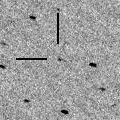
|
Now it is 14.8 mag (July 29, M. Tichy). Now it is brightest, and it will be fading after this. It keeps observable in good condition until it fades out in winter. The position is very different from the original prediction.
Date(TT) R.A. (2000) Decl. Delta r Elong. m1 Best Time(A, h)
July 26 3 9.85 12 17.2 1.686 1.727 74 15.3 3:25 (282, 38)
Aug. 2 3 24.91 13 14.5 1.648 1.742 77 15.3 3:33 (285, 42)
|
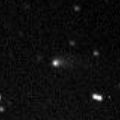
|
Now it is 16.0 mag (July 11, Ken-ichi Kadota). It will be 15.5 mag until October. It locates somewhat low in the Northern Hemisphere, but it keeps observable around 16 mag until winter.
Date(TT) R.A. (2000) Decl. Delta r Elong. m1 Best Time(A, h)
July 26 21 32.50 -29 20.8 2.022 3.001 161 15.9 1:18 ( 0, 26)
Aug. 2 21 27.14 -29 30.2 1.994 2.987 165 15.8 0:45 ( 0, 26)
|
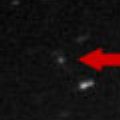
|
Now it is 16.8 mag (July 7, Gustavo Muler). It keeps observable while the comet will be brightening gradually after this. It will reach up to 14.5 mag in autumn. However, then it locates low in the evening sky, and it will be unobservable soon in December.
Date(TT) R.A. (2000) Decl. Delta r Elong. m1 Best Time(A, h)
July 26 15 25.64 -4 38.7 1.998 2.485 106 15.9 20:46 ( 35, 44)
Aug. 2 15 28.53 -5 16.2 2.037 2.441 100 15.8 20:38 ( 40, 41)
|
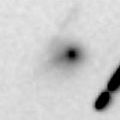
|
An outburst occured in late May, and it brightened up to 14.6 mag (May 23, Gustavo Muler). However, it faded down to the original brightness in late May. Now it is 17.3 mag (June 24, Catalina Sky Survey). It will reach to 14 mag in autumn, but it locates extremely low in the Northern Hemisphere.
Date(TT) R.A. (2000) Decl. Delta r Elong. m1 Best Time(A, h)
July 26 12 24.04 14 43.5 1.725 1.461 57 16.1 20:46 ( 91, 25)
Aug. 2 12 39.75 11 39.2 1.717 1.421 55 15.9 20:38 ( 89, 22)
|
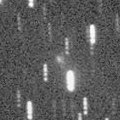
|
Now it is 16.0 mag (June 30, Michael Jager). It keeps observable in good condition after this in the Northern Hemisphere. It will be fading gradually, and will be fainter than 18 mag in November.
Date(TT) R.A. (2000) Decl. Delta r Elong. m1 Best Time(A, h)
July 26 23 22.72 47 45.6 1.949 2.372 101 16.2 3:07 (180, 77)
Aug. 2 23 18.39 50 25.5 1.956 2.417 104 16.3 2:36 (180, 75)
|
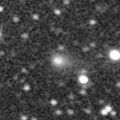
|
It was bright as 12.7 mag on May 12 (Juan Jose Gonzalez), and strongly condensed. However, it has been getting diffuse and fading rapidly after that. Now it is 16.6 mag (July 5, Ken-ichi Kadota). A temporary outburst seems to be ending. It keeps observable in good condition until autumn. But it is moving southwards gradually, and the altitude will be getting somewhat lower in the Northern Hemisphere. It must be already too faint to see visually.
Date(TT) R.A. (2000) Decl. Delta r Elong. m1 Best Time(A, h)
July 26 16 27.13 -18 55.8 1.810 2.530 124 16.4 20:46 ( 11, 35)
Aug. 2 16 29.45 -19 34.9 1.895 2.543 118 16.8 20:38 ( 15, 34)
|
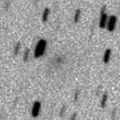
|
Now it is very bright as 15.0-15.5 mag (June 24, Michael Jager). However, it will be fading gradually, and getting lower rapidly in the evening sky after this. It will be fainter than 18 mag, and will be too low to observe, in September.
Date(TT) R.A. (2000) Decl. Delta r Elong. m1 Best Time(A, h)
July 26 14 30.64 28 27.1 1.745 1.903 82 16.5 20:46 ( 89, 57)
Aug. 2 14 34.97 22 18.4 1.833 1.937 80 16.7 20:38 ( 82, 51)
|
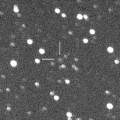
|
It was observed at 16.5 mag in last winter. Now it is appearing in the morning sky again. It will be observable at 15.5 mag in good condition in next autumn.
Date(TT) R.A. (2000) Decl. Delta r Elong. m1 Best Time(A, h)
July 26 4 19.10 20 47.5 3.778 3.331 56 16.6 3:25 (263, 28)
Aug. 2 4 17.09 21 15.1 3.650 3.330 63 16.5 3:33 (268, 36)
|
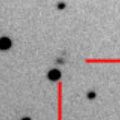
|
Not it is 17.7 mag (July 7, Siding Spring Survey). It will be brightening gradually after this, and reach to 12-13 mag in 2009 winter and spring. In the Northern Hemisphere, it keeps observable for a long time until 2009 May.
Date(TT) R.A. (2000) Decl. Delta r Elong. m1 Best Time(A, h)
July 26 21 44.88 -25 29.5 1.620 2.597 160 16.8 1:30 ( 0, 30)
Aug. 2 21 38.53 -26 19.5 1.550 2.546 165 16.6 0:56 ( 0, 29)
|
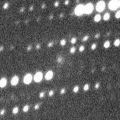
|
Now it is 15.0 mag (July 5, Michael Jager), brighter than this ephemeris. Moving northwards very fast, and it will be observable in good condition in the Northern Hemisphere after this. But it will fade out rapidly, and will be fainter than 18 mag in August.
Date(TT) R.A. (2000) Decl. Delta r Elong. m1 Best Time(A, h)
July 26 18 22.32 -16 32.0 1.457 2.398 151 16.6 22:03 ( 0, 39)
Aug. 2 18 6.98 -13 23.9 1.574 2.445 140 16.9 21:20 ( 0, 42)
|
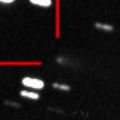
|
Now it is 16.8 mag (July 13, Gustavo Muler). It will be observable at 16 mag in good condition in autumn.
Date(TT) R.A. (2000) Decl. Delta r Elong. m1 Best Time(A, h)
July 26 2 22.24 11 8.8 1.942 2.133 86 16.7 3:25 (293, 46)
Aug. 2 2 33.51 11 39.7 1.863 2.125 90 16.6 3:33 (298, 51)
|
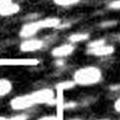
|
It was observed at 16.5-17 mag in 2007 autumn. Now it is 17.3 mag (July 2, J. F. Hernandez). It will be observable at 17 mag for a long time from summer to autumn.
Date(TT) R.A. (2000) Decl. Delta r Elong. m1 Best Time(A, h)
July 26 3 55.31 25 14.5 2.737 2.421 61 16.9 3:25 (262, 35)
Aug. 2 4 6.52 25 49.0 2.686 2.446 65 17.0 3:33 (264, 40)
|

|
It will brighten up to 12 mag in 2012. It is faint still in 2008, but observable at 17 mag in good condition.
Date(TT) R.A. (2000) Decl. Delta r Elong. m1 Best Time(A, h)
July 26 23 27.68 8 25.0 10.088 10.724 126 17.3 3:12 ( 0, 63)
Aug. 2 23 25.11 8 17.2 9.961 10.687 133 17.3 2:42 ( 0, 63)
|

|
It was observed at 17.5-18 mag in 2006 and 2007. In 20080, it will be observable at 17.5-18 mag from summer to autumn.
Date(TT) R.A. (2000) Decl. Delta r Elong. m1 Best Time(A, h)
July 26 22 55.77 -19 34.8 3.281 4.145 143 17.3 2:41 ( 0, 35)
Aug. 2 22 53.66 -20 23.2 3.233 4.147 150 17.3 2:11 ( 0, 35)
|
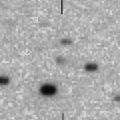
|
It will be observable at 17 mag in good condition in autumn.
Date(TT) R.A. (2000) Decl. Delta r Elong. m1 Best Time(A, h)
July 26 0 37.62 29 12.6 1.899 2.326 101 17.6 3:25 (292, 77)
Aug. 2 0 44.34 29 47.3 1.824 2.321 106 17.5 3:33 (309, 82)
|
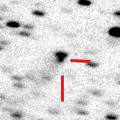
|
It was observed at 16.5-17 mag in 2006 and 2007. Because it is a very distant comet, it is observable at 17 mag still in 2008 in good condition.
Date(TT) R.A. (2000) Decl. Delta r Elong. m1 Best Time(A, h)
July 26 18 10.14 44 40.5 6.008 6.414 109 17.5 21:51 (180, 80)
Aug. 2 18 2.51 44 25.7 6.062 6.434 107 17.5 21:16 (180, 81)
|

|
It must have already brightened up to 18 mag. It will brighten rapidly after this, and it will reach up to 10 mag in winter. It keeps observable in good condition for a long time until early summer in next year when the comet fades out.
Date(TT) R.A. (2000) Decl. Delta r Elong. m1 Best Time(A, h)
July 26 2 6.27 16 42.7 2.196 2.389 88 18.2 3:25 (290, 53)
Aug. 2 2 15.74 17 35.0 2.066 2.340 92 17.8 3:33 (295, 58)
|

|
It is expected to reach up to 7 mag in winter, and will be observable in good condition. However, this comet has not been observed since 1986. It was not detected, fainter than 18 mag, on May 31 (Katsumi Yoshimoto). Nothing brighter than 20.6 mag was found around the predicted position on June 12 (Mitsunori Tsumura). It is predicted to be so faint as 19 mag still now. But it will brighten very rapidly near by the perihelion. It will be 18 mag in August. The condition of this apparition is good. It keeps observable for a long time until 2009 early summer both in the Northern Hemisphere and Southern Hemisphere.
Date(TT) R.A. (2000) Decl. Delta r Elong. m1 Best Time(A, h)
July 26 20 24.32 -24 38.2 1.148 2.161 174 18.7 0:10 ( 0, 30)
Aug. 2 20 15.34 -24 58.9 1.090 2.096 169 18.1 23:28 ( 0, 30)
|

|
No observations have been succeeded since 2007 July. It was predicted to be so bright as 14 mag now. But actually, it is fainter than 19 mag and not detectable (June 1, Gustavo Muler). It will locate in good condition from spring to summer. But it seems to have already disappeared.
Date(TT) R.A. (2000) Decl. Delta r Elong. m1 Best Time(A, h)
July 26 22 26.41 15 5.5 1.521 2.342 133 20.3 2:11 ( 0, 70)
Aug. 2 22 24.15 15 50.5 1.521 2.383 139 20.4 1:42 ( 0, 71)
|

|
It was observed at 16-17 mag at the discovery in 1999. It is predicted to be already 18 mag. But actually, it was not detected, fainter than 22.5 mag, in 2006 September (Carl Hergenrother). So it must be now fainter than at the discovery by 3-4 mag.
Date(TT) R.A. (2000) Decl. Delta r Elong. m1 Best Time(A, h)
July 26 0 19.11 5 24.7 3.652 4.207 116 21.4 3:25 (341, 59)
Aug. 2 0 19.02 5 30.7 3.544 4.189 123 21.4 3:33 (358, 61)
|
|
![]()
 C/2005 L3 ( McNaught )
C/2005 L3 ( McNaught ) 51P/Harrington
51P/Harrington 47P/Ashbrook-Jackson
47P/Ashbrook-Jackson 68P/Klemola
68P/Klemola 7P/Pons-Winnecke
7P/Pons-Winnecke C/2008 J6 ( Hill )
C/2008 J6 ( Hill ) P/2008 J2 ( Beshore )
P/2008 J2 ( Beshore ) C/2007 W3 ( LINEAR )
C/2007 W3 ( LINEAR ) C/2007 U1 ( LINEAR )
C/2007 U1 ( LINEAR ) 67P/Churyumov-Gerasimenko
67P/Churyumov-Gerasimenko C/2008 J5 ( Garradd )
C/2008 J5 ( Garradd ) 61P/Shajn-Schaldach
61P/Shajn-Schaldach 44P/Reinmuth 2
44P/Reinmuth 2 C/2006 S3 ( LONEOS )
C/2006 S3 ( LONEOS ) P/2006 F1 ( Kowalski )
P/2006 F1 ( Kowalski ) P/2008 L2 ( Hill )
P/2008 L2 ( Hill ) C/2005 S4 ( McNaught )
C/2005 S4 ( McNaught ) 144P/Kushida
144P/Kushida 85P/Boethin
85P/Boethin C/2007 K3 ( Siding Spring )
C/2007 K3 ( Siding Spring ) P/1999 WJ7 ( Korlevic )
P/1999 WJ7 ( Korlevic )![]()






























